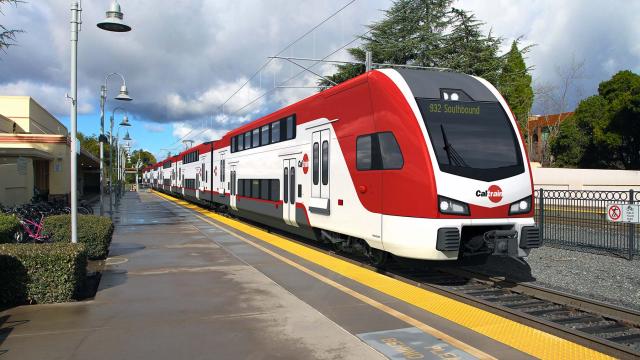More Trains, More Often
More Commute Service
8 Rush Hour Trains per Hour, Each Way
Plus capacity for 4 HSR trains, compared to 5 total trains today
More Flexibility
UP TO 6 MIDDAY & WEEKEND TRAINS
Per hour, each way, compared to 1 train today
More Frequent Service
21 Stations with Trains Every 15 Minutes
Compared to 6 stations today
Improved Express Service
Show Up and Go
15 Minute Express Train Service All Day
Compared to no all-day express service today
Faster Travel
San Francisco to San Jose in Less than an Hour
Compared to 62–69 minutes today
More Options
12 Stations with Express Train Service
Compared to 6–9 stations today
More People Served
Triple the People Served
180,000 Riders on Caltrain Each Day
Compared to 65,000 today
A More Connected Corridor
77 Miles of All-Day Service
Sf Salesforce Transit Center to SJ to Gilroy
Compared to 50 miles of all-day service today
Why Plan a Future Service Vision?
Over the last 15 years, Caltrain’s ridership has more than doubled, and today Caltrain is the 7th largest commuter rail system in the country. We are also the nation’s most efficient commuter railroad as measured by both the percentage of our costs we recover through fares and the number of passengers and train miles we deliver per employee.
We are proud of our success, but we also want to do more. By 2040, regional growth projections show that there will be 1.2 million additional people living and working within 2 miles of our stations—a 40% increase from today. We want to make sure that our service, and our system, is ready. A future service vision provides the roadmap for the railroad to grow—showing us how we can improve the experience of our customers today and meet the needs of our region in the future.
The Draft Vision Benefits the Bay Area’s People, Environment, and Economy
More Transportation Capacity
Carrying More People
Improving Caltrain lets us carry three times more people in 2040. That’s equivalent to selling out the Giants’ ballpark four times every day.
Trains vs Lanes
Today, Caltrain carries 4 freeway lanes worth of people during rush hour. The draft vision adds the equivalent capacity of 5.5 new freeway lanes.
Improving Air Quality
Reducing Driving
825,000 Fewer Miles Driven Each Day
Resulting from drivers who switch to Caltrain. That’s like taking 16,000 trips between SF and SJ off the road each day
Reducing Greenhouse Gas Emissions
110 Fewer Metric Tons of C02 Emissions Each Day
Resulting from full electrification of our fleet and drivers switching to Caltrain
Stimulating the Economy
Adding Jobs
51,000 New Jobs Created
Total full- and part-time jobs along the corridor resulting from Caltrain investment*
Increasing Economic Activity
$40.8 Billion Impact on the Region
Total impact on regional spending and economic activity resulting from Caltrain investment*
* Values are for 2018–2070 and are in present (2018) value using a discount rate of 4.0%
The Draft Vision Benefits the Bay Area’s People, Environment, and Economy
Capital Costs
$23 Billion
Total Capital Costs*
including all projects from SF to Gilroy, knitting together a connected corridor with greatly improved service.
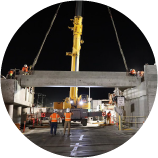
$9.4B
Grade Separations
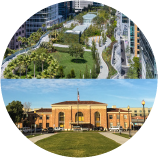
$7.8B
Terminal Improvements
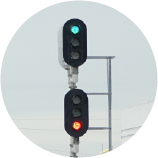
$3.3B
Rail Infrastructure and Systems
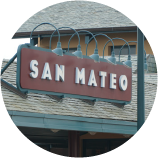
$1.4B
Station Improvements
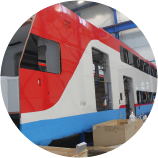
$1.1B
Fleet Upgrades
Operating Costs
$370 Million
2040 Annual Operating Costs*
Caltrain is one of the leanest, most efficient transit services in the country. Today’s annual operating and maintenance costs are $135 million, and 73% is covered by fares. The vision would benefit from a similarly high farebox recovery ratio.

Implementing the Vision
Electrifying Caltrain 2022
Our Work toward the Vision Is Already Underway
Thanks to the $2 billion investment in the Caltrain Electrification Project, we are already laying the foundation for implementing the vision. We will deliver this vision in steps and will be mapping out the sequence of near term priorities in the second phase of the Caltrain Business Plan. In order to fully implement the vision, new local, regional, state, and federal resources will be required. Read more about our upcoming electrified service at calmod.org.
* Capital and operating costs are in present (2018) value
Service Vision 2040
Getting Ready to Deliver the Vision
Growing Caltrain service will also require Caltrain to grow as an agency. The organization will need to be strengthened and resourced in a way that helps deliver major capital projects and expanded operations throughout the corridor. The Caltrain Business Plan includes a detailed evaluation of organizational options that should be considered to make the vision a reality. The full organizational assessment is available on the Service Vision page.
The Draft Vision Lays the Foundation for Expanded Regional Service

Growing beyond Our Vision
Caltrain is ready for additional investment as planning for expanded Bay Area rail continues. With additional passing tracks and infrastructure, we can expand service from 12 to 16 trains per hour, creating opportunities for even more service and enhanced connectivity to other regional rail corridors.

The Draft Vision Is a Shared Partnership with Our Stakeholders and Communities

Engaging with Stakeholders
The vision planning started in 2017. A collaborative effort led by Caltrain with funding from various partners, the vision is the product of hundreds of hours of meetings with cities, counties, business groups, public agency partners, advocates, and public stakeholders throughout the corridor.
The vision is still a draft recommendation that is being discussed with the public. The Caltrain Board is expected to adopt it as early as October 2019, and staff will complete the Caltrain Business Plan by early 2020.

Letter From Caltrain Ceo
Read Caltrain CEO, Jim Hartnett’s Letter on the Service Vision
